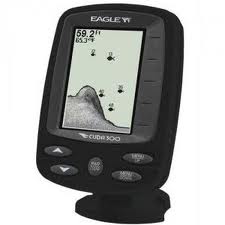
A basic unit such as the Eagle Cuda 300 is a good choice for the casual angler. It's priced in the $100 range and its black and white display will give you all the data you need.
The once simple act of casting a line into the water has now gone high tech. Today’s fish finders are helping fishermen everywhere, thanks to their state of the art GPS and sonar technology that help you find fish faster so you can catch more of them.
These instruments not only help locate the fish but display them clearly on a map of the terrain, and also help you keep track of your exact location.
The transducer communicates with the display unit via wiring, and it sends the information it has gathered to the screen so you can see exactly what’s beneath you, even as you’re traveling through the water.
Transducers operate on various frequencies, so the information you see will depend on the quality of your unit and your ability to set it for the current conditions. In most cases, you’ll get all the information you need to spot the fish quickly.
A basic unit such as the Eagle Cuda 300 is a good choice for the casual angler. It’s priced in the $100 range and its black and white display will give you all the data you need.
Some people prefer more options however, including color screens with higher resolution and greater GPS connectivity. There are some good mid range products available for $200 to $500, and you can go all the way up to $2500 for something like the Lowrance HDS 10.
Fish finders can actually do much more than simply locate fish. Depending on the model you choose, it can do everything from determine the depth and temperature of the water to displaying the speed at which you’re traveling through the water. If your instrument is GPS enabled, you can also download local maps, get the weather forecast and pinpoint your location with precision.
You’ll want to make sure you do some research before choosing a fish finder. Read some online reviews, both from professionals and from customers. This will give you a lot of helpful information about the available features and which ones will actually be of any use to you.
Return to the home page of Mad Progress

